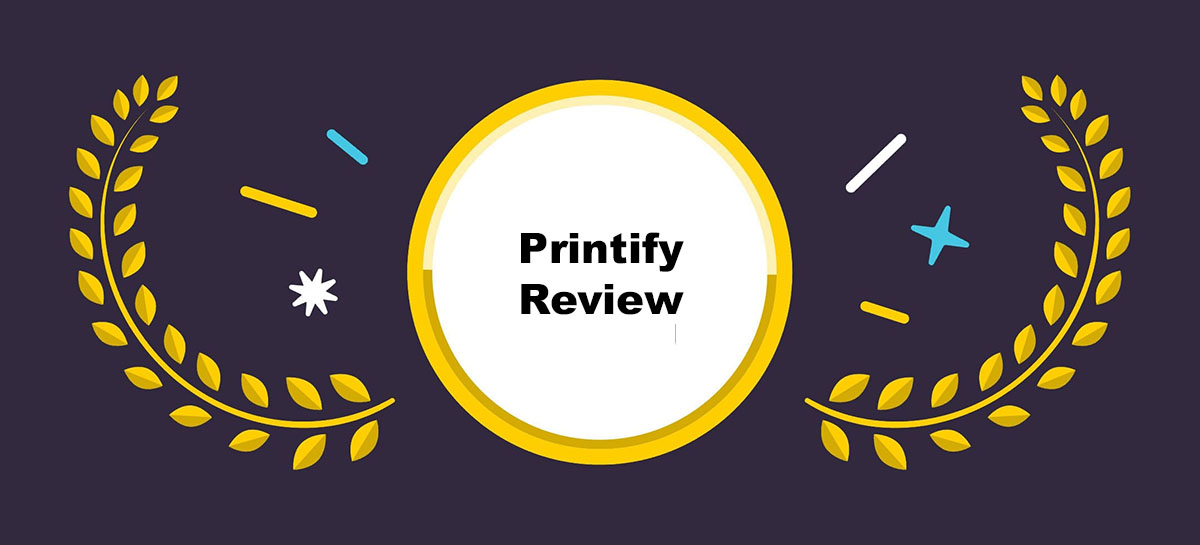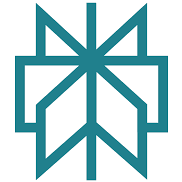It’s probably safe to say I’ve tested far more print on demand platforms than the average seller at this point.
I’ve experimented with market leaders in sustainability like Gelato, premium powerhouses like Printful, even POD marketplaces like Spring. But Printify is still one of my favorites.
Obviously, I’m not alone here – Printify has managed nearly 60 million POD orders, serving companies in over 200 countries worldwide. It’s kind of a big deal.
At first glance, Printify might look like just another POD platform. But it’s so versatile, flexible, and scalable compared to many other options.
You can experiment with countless different printing partners, products, and even sales channels. Plus, with the recent Printful-Printify merger, this POD leader is poised to become even more of a major contender.
The question is, is Printify right for you?
That’s what I’m going to help you figure out. I’m not going to sugarcoat things. I’ll tell you where Printify shines and where it seriously needs to step it up.
Quick Verdict: Pros and Cons
Let me give it to you straight: Printify is hands-down one of the most scalable POD platforms out there. It’s built for flexibility, whether you’re just testing your first design idea or managing ten online stores at once.
You get access to over 1,000 products (including some truly niche items like supplements and scented candles), integrations with all the major ecommerce platforms (plus TikTok Shop), and the ability to pick your print partners based on price, shipping speed, and even location.
But it’s not perfect. The quality of your products will depend heavily on which manufacturer you choose. I’ve had a mug arrive with a flawless print, and a hoodie from a different vendor show up slightly off-center.
Support can also be hit-or-miss. There’s 24/7 chat and email, but during high-volume times (like Q4), response times stretch. I’ve waited 24+ hours more than once.
Still, those drawbacks haven’t stopped me from using it as my primary POD platform.
Quick Pros and Cons
Pros:
- Over 1,000 customizable products (from apparel to supplements)
- Competitive base pricing + Premium discounts (up to 20%)
- Choose your print partners for better control
- Seamless integrations with Shopify, Etsy, Walmart, TikTok Shop & more
- Great design tools, including an AI image generator
- Free pop-up shop creator, great for testing ideas
- Global fulfillment across 100+ locations
Cons:
- Product quality varies between print providers
- Support can be slow during busy seasons
- No phone support
- Branding options are limited unless you scale into Enterprise
The Core Features
I know, you’re not just interested in what I think or feel about Printify – you want the details. What kind of products can you sell, how much money can you make, how much does it all cost – everything. So let’s dive into the big stuff.
Product Options & Customization Tools
I said before that I’ve tried a lot of print on demand platforms. That’s true, and I’ve yet to find one that offers as much range as Printify.
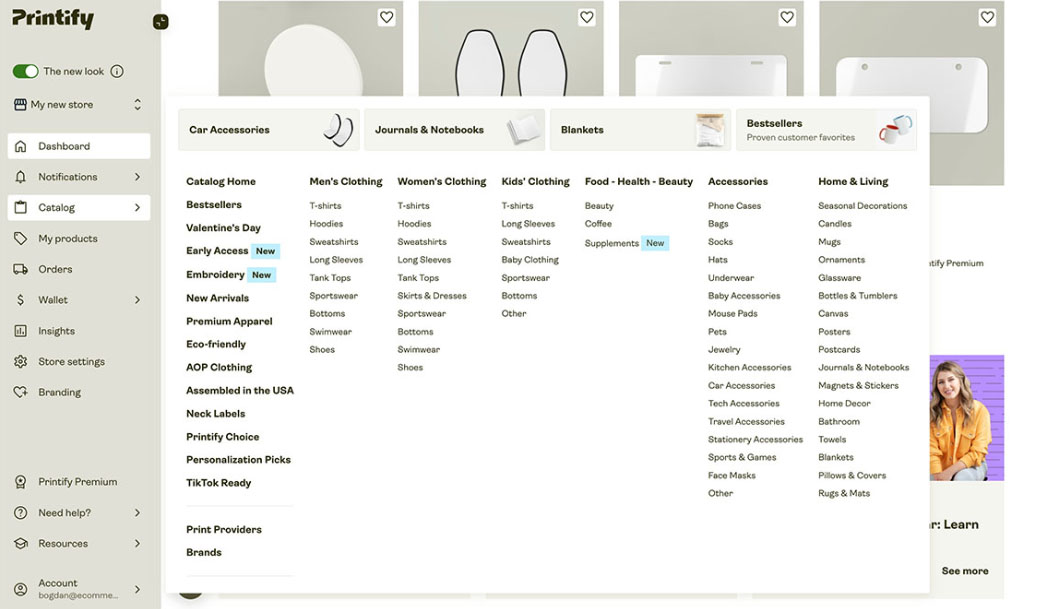
Printify laughs in the face of other companies offering the same handful of customizable t-shirts and mugs. You can create just about anything you can imagine.
Embroidered caps, jewelry, pet products, kitchen accessories, sports bags, swimwear – anything. There are even options for creating custom supplements, coffee, and beauty products.
If you want to expand your portfolio, Printify’s got you.
But it’s not just the massive selection of products you can experiment with that makes Printify so impressive – it’s what you can do with them.
Printify offers embroidery, DTG, sublimation, all-over print, and even UV printing for some items.
The product design tools are phenomenal too. You can add your own images, patch in some clip-art, adjust font placement pixel by pixel, change color combinations and more without becoming a tech wizard.
There’s even an AI-powered image generator, which I absolutely love playing with.
You enter a prompt, choose a style, and it spits out custom images you can use instantly. I’ve used it to create retro poster art, surreal floral designs, and even quick mockups for trending memes.
Product Quality & Profitability
Ok, so the product options are amazing, and the design tools are incredible – but how does this all translate into the quality of the items your customers actually get.
Simply put – it varies. Printify does have a good reputation (a score of 4.7 out of 5 on TrustPilot, for instance), and a lot of customers, including me, end up with great products most of the time.
The issue is that you’re not always guaranteed consistency.
Printify is a network, not a manufacturer. It connects you to 100+ global print partners, some excellent, some less so.
That’s not to say Printify doesn’t do its due diligence – it still runs careful quality checks – but things can occasionally slip through the cracks.
I’d always recommend ordering samples before you choose anyone new to work with – just in case. On the plus side, Printify does show you the reviews left by other companies for print partners – so you can make a pretty informed decision.
In terms of profit margins – Printify’s products are very affordable – although there are some cheaper options out there.
As your business scales, I’d probably recommend switching to the Printify Premium plan, so you can take advantage of up to 20% off all your products. Those savings do add up over time.
Here’s a real example: I used to pay $17.09 per custom hoodie. On Premium, it dropped to $13.74. Multiply that by 50 sales in a month, and you’re saving $167.50.
That $29 fee pays for itself by week two. Combine that with Printify’s profit calculator and vendor filtering tools (lowest price, fastest shipping, best rating), and you can dial in your costs like a pro.
Global Fulfillment, Integrations & Pop-Up Shop
Logistics is one of Printify’s biggest strong points. It has fulfillment partners located across numerous countries and territories, so you really can ship products worldwide, without having to worry about really long waiting times or high costs.
I’m UK-based, and Printify makes it easy to prioritize local print providers like Print Clever and Jondo. This translates to faster delivery times and lower shipping costs for my UK customers.
Better still, I can filter vendors by location, so I don’t have to guess who’s closest.
Shipping times do vary. In the US, most orders hit customers in 3–8 days. In Europe, it’s more like 4–10. But again, it depends on your supplier.
Some are blazing fast, others drag. I’ve had European mugs arrive in 5 days and US tees take 12.
Now, from an integration perspective, Printify gives you a lot of options.
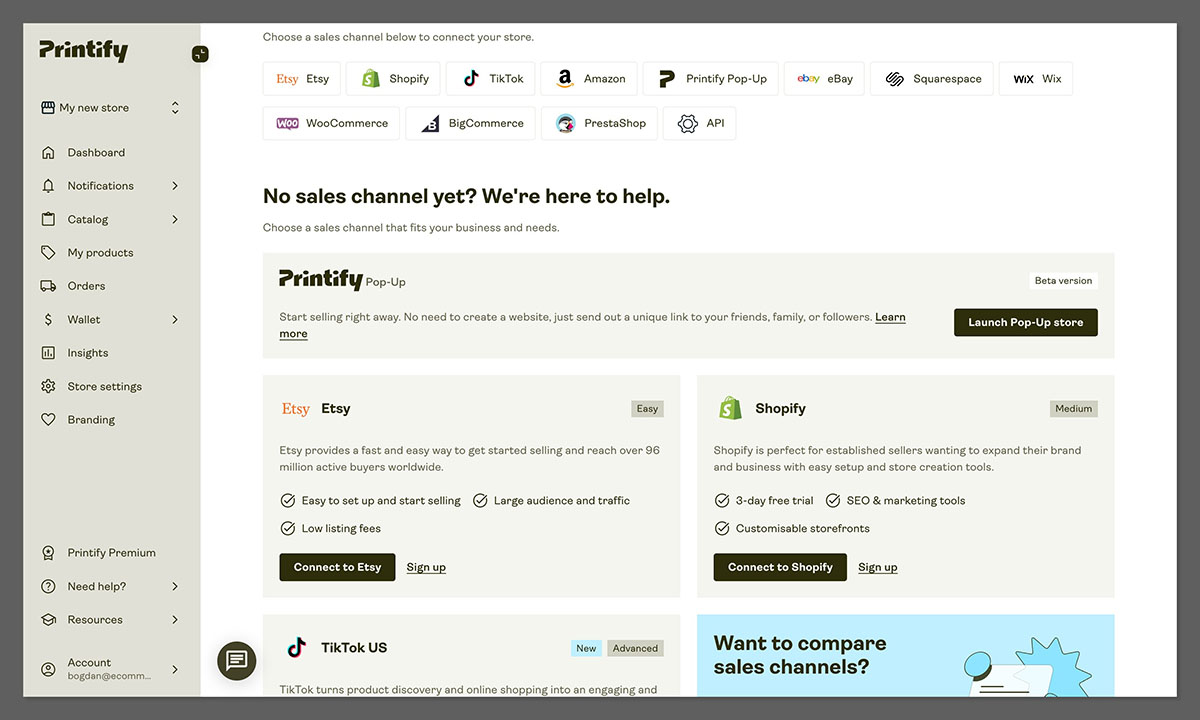
It works with Shopify, Etsy, TikTok Shop, Walmart, WooCommerce, Squarespace, Wix, BigCommerce, and more. You can even connect it via API if you’re running something custom.
I personally run three stores (Shopify and Etsy), and the syncing is seamless.
If you don’t have a store yet, Printify’s Pop-Up Shop is surprisingly good. It’s not a whole ecommerce platform, but you do get a basic, no-frills single-page storefront for free.
I’d definitely recommend giving it a try if you’re testing out niche collections, or you’re new to selling.
Ease of Use & Customer Support
I’m not going to make outlandish claims that Printify is the most user-friendly POD platform out there. Most of the platforms I’ve used are beginner-friendly.
But Printify’s overall experience is refreshingly clean and robust. Here’s a quick look at the layout:

You don’t need a design degree or ecommerce background to get going. Everything is laid out cleanly, and the dashboard isn’t cluttered with unnecessary noise.
From the minute you create your account, Printify guides you with a straightforward onboarding checklist.
You’ll be adding products to your store in no time. The drag-and-drop design editor is responsive and fun to use.
If you want to slap some AI-generated flamingo art on a pillowcase, you can do that in under two minutes. The mockup preview updates in real-time, which is great for visualizing exactly what your customer will see.
Where things get a little more advanced is in order management and automation. If you connect to Shopify or Etsy, Printify can auto-route orders to vendors, handle shipping updates, and even manage VAT invoices if you’re in the UK.
There’s a learning curve for automation settings, but it’s manageable, even for non-techies.
The Customer Support
Now, onto the less glamorous part: customer support.
Printify advertises 24/7 support via live chat and email, and it does deliver – but response times vary. I’ve had chat replies in 30 minutes and others that took a full day.
During Q4 or when there’s a big system update, that wait time stretches even longer.
There’s no phone support, which can be frustrating when you have a customer breathing down your neck about a late delivery.
That said, the Help Center is solid, and the Printify Academy offers some genuinely helpful tutorials and webinars (especially for newbies).
If you’re a seller outside the U.S. (like me in the UK), some mentorship and regional support tools aren’t available.
That’s a bit of a miss. But there’s still enough there to guide most users through 90% of situations without needing human help.
The Pricing: Plans, Costs & Value
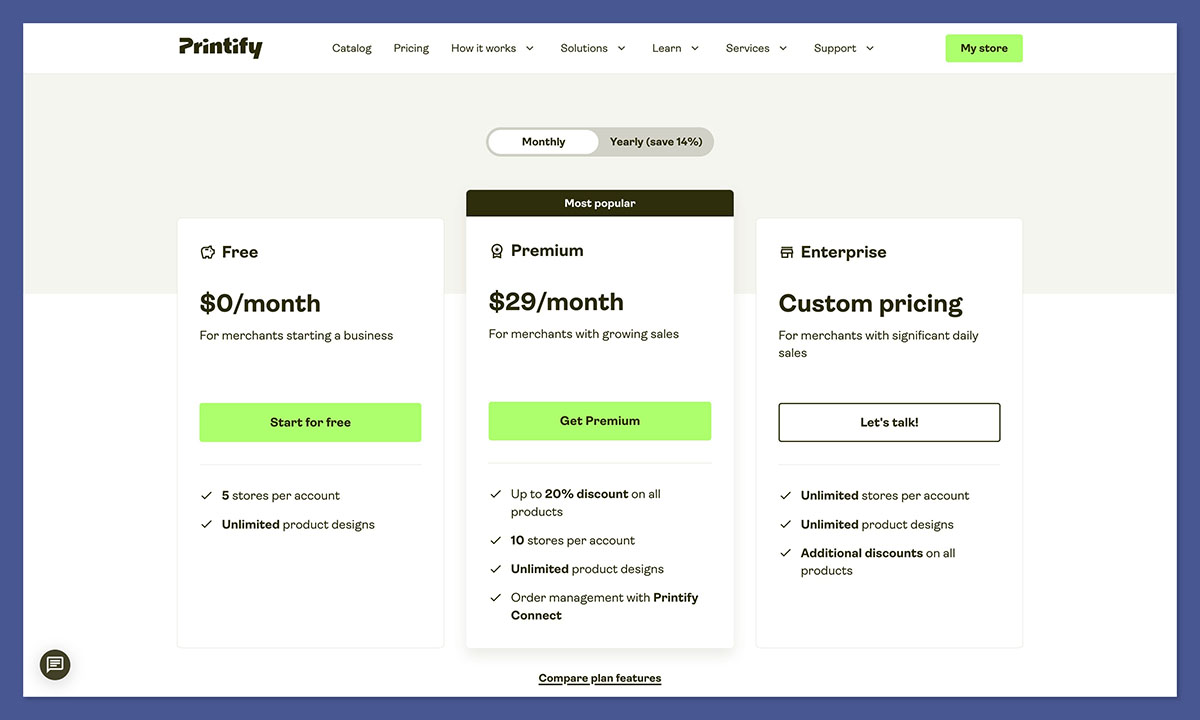
Onto the pricing. I already mentioned that Printify’s product prices are pretty cheap (depending on your chosen manufacturer and what you’re ordering).
Everything really does depend on the people you partner with – including the shipping costs.
However, on the plus side, you can get started for free. The free plan is the one I recommend to most beginners.
You get five stores per account, and unlimited product designs. Plus, you can access the full catalog, and all the handy design tools Printify has to offer.
When your business starts to scale, that’s when I recommend upgrading. Printify Premium is 29/month (or $24.99 if paid annually), and it gets you:
- Up to 10 stores
- Up to 20% off all product base costs
- Better profit margins
- Access to Printify Connect (for smarter order management)
The extra 20% off really does make a difference. Quick example: An accent color mug will cost you around $6.90 (starter price) with a standard account, or $5.31 with Premium.
Sell 50 of those mugs in a month for $12 each, and you’re earning $334.50 with Premium, compared to $255 after fees on the standard plan.
Even when you take off the $29 fee, you’re still left with around $50 in extra profit.
If you’re scaling fast, there’s also an Enterprise plan, with custom pricing, unlimited stores, API integrations, and a dedicated account manager. I’m not quite there (yet), but I know sellers doing 500+ orders a month who swear by it.
Final Verdict: Should You Use Printify?
So, do I recommend Printify? Absolutely – with a few caveats.
If you’re brand new to print-on-demand, Printify’s free plan and intuitive dashboard make it a fantastic place to start.
You can test ideas without spending a dime, explore niche products beyond the basics, and sell on your favorite platforms with minimal friction.
If you’re scaling, or already selling 20+ items a month, the Premium plan is incredibly valuable. Those discounts boost your profit margins, especially on high-volume SKUs like tees, mugs, and hoodies.
The downsides? Quality control isn’t centralized, so you have to vet your suppliers carefully.
Support isn’t perfect, and there’s a learning curve when it comes to automating workflows or managing multiple vendors. But those aren’t deal-breaking issues for me.
With the upcoming full integration of Printful and Printify’s combined strengths, we’re looking at a POD platform that might soon set the industry standard.
So yes, Printify isn’t flawless, but it’s smart, flexible, and profitable- well worth serious consideration for any creator.

